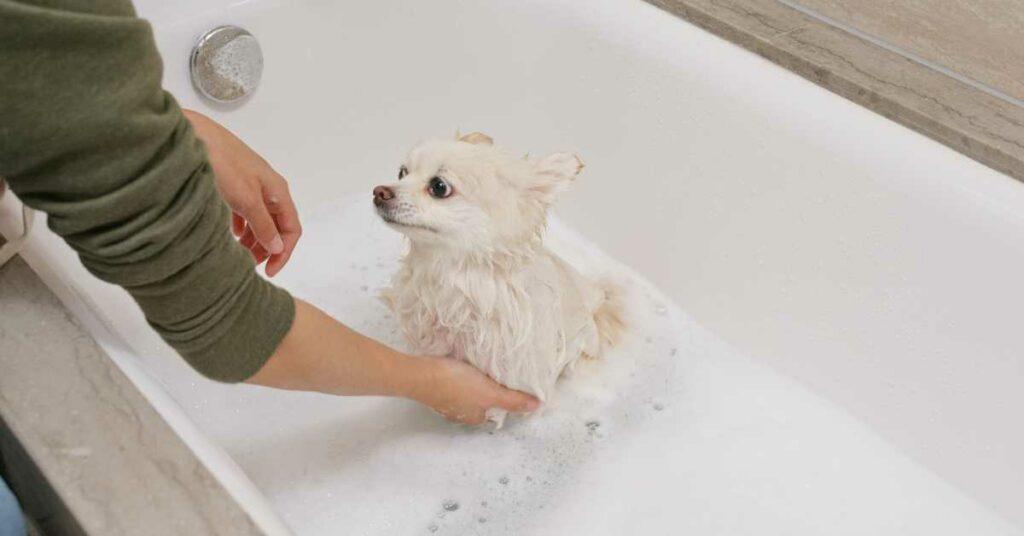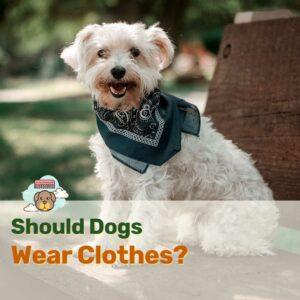Welcoming a new puppy into your home is an exciting experience, and it’s essential to make sure your furry friend stays clean and comfortable.
Bathing your puppy is an important part of their care routine, but it’s not as straightforward as you might think.
In this guide, we’ll walk you through everything you need to know on how to bathe a puppy, from when to start to how to make it a positive experience for both of you.
When Can Puppies Have Their First Bath?
Your adorable pooch might arrive home covered in the scent of the rescue or kennel they came from. While it’s tempting to give them a bath immediately, it’s generally recommended to wait until they are around 8 weeks old (or 2 months old). There are a few good reasons for this:
- Temperature Regulation: Puppies are not very good at regulating their body temperature when they are very young. Bathing them too early could expose them to temperature extremes that they can’t handle.
- Familiarity: Your puppy is adjusting to a new environment and needs time to settle in. Give them a few days and let them get used to your home and the scents around them before you introduce a bath.
- Scent Matters: A dog’s sense of smell is incredibly important to how they experience the world. Bathing them too soon can strip away their natural scent, which can be confusing and stressful for them.
- Vaccination Timing: You should also avoid giving your puppy a bath within a week after they’ve had their vaccinations. This is to ensure their immune system has time to respond to the vaccines properly.
As a responsible pet owner, it’s crucial to prioritize your puppy’s comfort and well-being over the desire to have a freshly bathed pup. Once they’ve settled into their new home and reached the appropriate age, you can start planning their first bath.
How Often Should You Bathe a Puppy?
The frequency of bathing your puppy depends on several factors, including their breed, activity level, and lifestyle. In general, puppies do not need frequent baths. Over-bathing can strip their coat of natural oils and lead to skin issues. Here’s a general guideline:
- Infrequent Bathing: If your puppy is not particularly smelly or dirty, you can simply wipe them down with a lukewarm, damp cloth. This can help keep them clean without the need for a full bath.
- Monthly or as Needed: For most puppies, a bath once a month or when they get into something particularly messy is sufficient. Over-bathing can lead to dry skin and coat problems.
Remember, always use a dog-specific shampoo when you do bathe your puppy. Human shampoos are formulated for human skin and can be too harsh for your furry friend.
What You Will Need for Your Puppy’s First Bath
Before you give your puppy their first bath, it’s essential to gather all the necessary supplies to make the process smoother. Here’s a checklist:
- Brush: Choose an appropriate brush based on your puppy’s hair type, whether it’s long, short, coarse, or curly. Brushing helps remove loose hair and tangles.
- Dog-Specific Shampoo: Select a gentle, dog-specific shampoo. Avoid using human shampoos as they can irritate your puppy’s skin.
- Towels: Have plenty of soft towels on hand to dry your puppy thoroughly.
- Cotton Balls: Use these to plug your puppy’s ears to prevent water from getting inside.
- Non-Slip Mat: Place a non-slip mat at the bottom of the bathtub to keep your puppy from slipping and sliding.
- Treats: Treats are handy for rewarding your puppy during and after the bath, making it a more positive experience.
- Foresee Potential Distractions: Ensure there are no distractions during the bath. Supervise other pets or children, avoid cooking, and mute your phone to give your puppy your full attention.
- Additional Help: Especially during the first few baths, having an extra pair of hands can be incredibly helpful. Enlist a family member or friend to assist you in keeping your puppy calm and secure during the process.

How to Bathe a Puppy: Step-by-Step
Step 1: Prepare the Bath Area
- Set the water temperature to be comfortably warm for your puppy, similar to what you’d use for a baby. Puppy skin is sensitive, and overly hot water can cause discomfort or even hyperthermia.
- Place a non-slip mat at the bottom of the bathtub to prevent slipping.
- Place cotton balls in your puppy’s ears to keep water out.
- Have all your supplies within easy reach.
Step 2: Gentle Introduction
- Begin by gently introducing your puppy to the water without actually wetting them. Let them feel the sensation of water with your hands. Use calm and reassuring words to help them relax.
Step 3: Wet Your Puppy
- Gradually wet your puppy’s fur with lukewarm water, starting from their back and moving toward their head.
- Be cautious around your puppy’s face, and use a damp washcloth to clean this area.
Step 4: Shampoo Time
- Apply a small amount of puppy shampoo to your hands and lather it gently into your puppy’s coat.
- Be extra gentle around sensitive areas like the eyes, ears, and mouth. Use a damp washcloth to clean these areas carefully.
Step 5: Rinse Thoroughly
- Rinse your puppy thoroughly with lukewarm water, ensuring all shampoo is washed out.
- Pay close attention to rinsing the belly and paws, as these are common spots where shampoo residue can linger.
Step 6: Towel Dry
- Gently towel dry your puppy, being careful not to rub too vigorously. Make sure they are completely dry, especially in cooler weather.
- Your puppy may also shake off excess water during this step, so be prepared for a little splashing.
Step 7: Post-Bath Reward
- Reward your puppy with treats and praise to create positive associations with bath time.
Dry the Puppy
It’s crucial to ensure your puppy is completely dry after their bath. Leaving them damp or choosing air dry for thick coat puppy can lead to skin issues and discomfort.
Use soft towels and consider using a hairdryer on a low, cool setting, keeping it at a safe distance from your puppy’s skin. Best if you can use a dog specific hairdryer.
Bathing a Puppy: Top Tips
- Start Early: Get your puppy accustomed to baths from a young age. Positive early experiences can help them grow into dogs that are comfortable with baths.
- Stay Calm: Dogs can pick up on your emotions. If you’re nervous or anxious, your puppy might become anxious too. Stay calm and reassuring throughout the process.
- Use Treats: Treats are a great way to reward your puppy for good behavior during the bath.
- Avoid Eyes and Ears: Be extremely cautious around your puppy’s face, eyes, and ears. Use a washcloth to gently clean these areas.
Last Resort: Sending Your Puppy to the Groomer
If you find that bathing your puppy at home is a challenging task, or if you have a breed with a coat that requires professional grooming, consider sending them to a groomer.
However, it’s generally best to wait until your puppy is fully vaccinated and has tick prevention measures in place before taking them to a grooming salon.
Remember that patience, positive reinforcement, and a gentle touch are key to ensuring that bath time becomes a positive experience for your puppy. Over time, they may even come to enjoy their baths as part of their routine grooming.
Conclusion
Bathing your puppy for the first time can be a memorable experience. By waiting until they are around 8 weeks old and using the right supplies and techniques, you can make bath time a positive and enjoyable ritual for both you and your furry friend. With patience and consistency, your puppy will grow to become a clean and happy adult dog.
See Other Grooming Tips:






